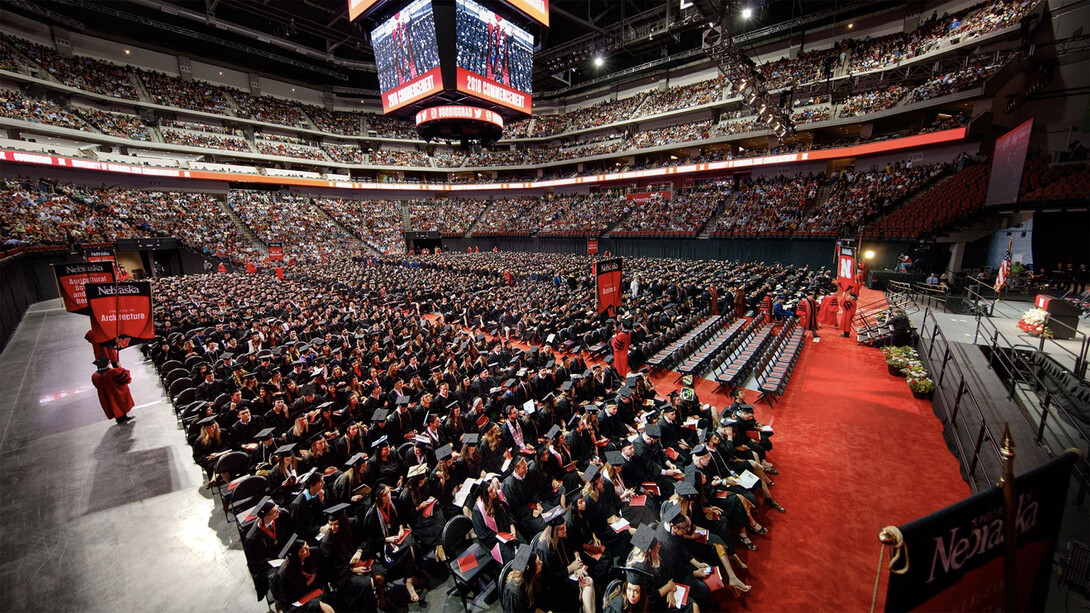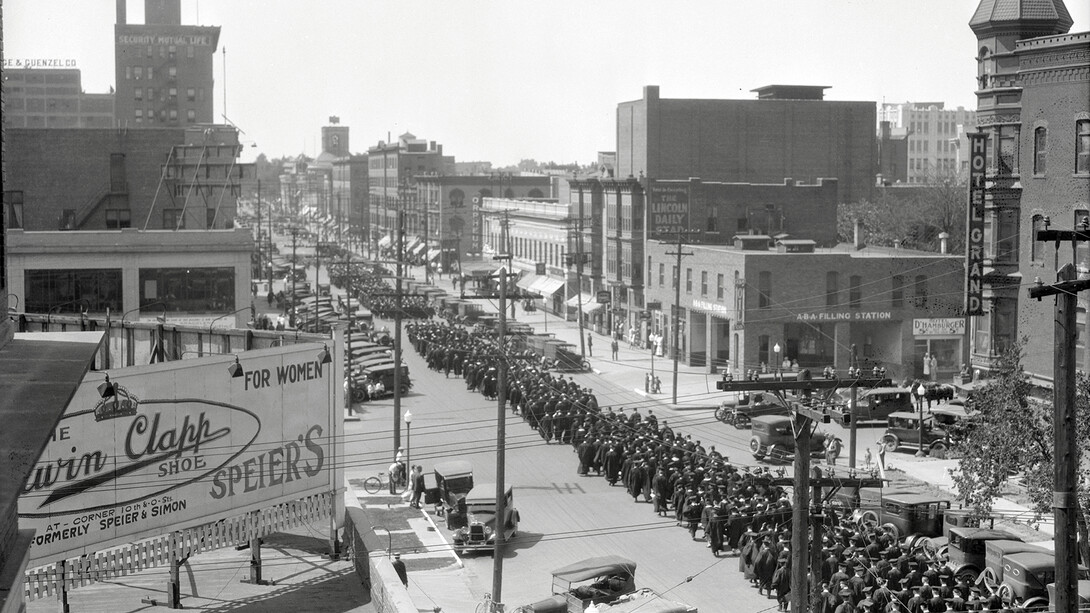
For nearly 150 years, the commencement ritual at the University of Nebraska–Lincoln has brought students and their families together, cultivating alumni relationships, and reinforcing the campus family of faculty and administrators.
During the 1870s proud family members threw flowers onto the stage at the feet of graduating seniors. In war years families and educators gathered immediately after commencement to see graduates off to war. And, today’s families celebrate with photographs and shouts of joy as their graduate walks across the stage to receive a hard-earned diploma.
As the university prepares for spring commencement in this 150th year of the institution, Nebraska Today is reprinting Annette Wetzel’s article on the history of graduation on campus. The article, which was published in the summer 2005 edition of the University of Nebraska’s alumni magazine, is based on Wetzel’s master’s thesis. Wetzel, who lettered as a Husker swimmer and is director of the Van Brunt Visitors Center, is a two-time Nebraska graduate, having earned a bachelor’s degree in 1983 and master’s in 2004.
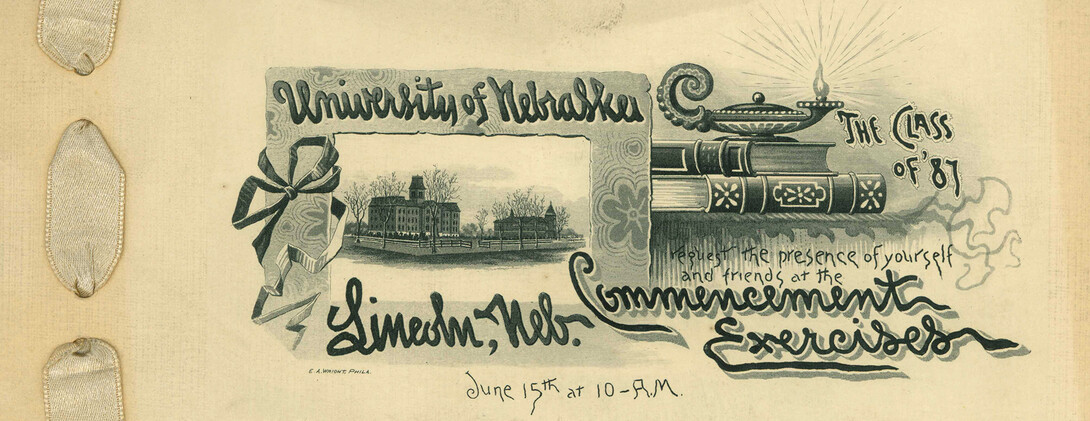
The Early Years
The University of Nebraska’s first commencement was unusual because there were no graduates.
The inaugural ceremony was held in the University Hall chapel on June 26, 1872. At the close of his review of the achievements of the year, Chancellor Allen R. Benton announced that although the university could not present a graduating class at its first commencement, the Board of Regents would confer a degree upon one of Nebraska’s sons. The audience applauded as Rev. Bishop Clarkson of Omaha was presented an Honorary Doctor of Laws degree.
On June 25, 1873, at the Academy of Music, 1041 O St., the second “first” commencement of the University of Nebraska was held with two graduates — William H. Snell and James Stuart Dales.
During the ceremony, commencement speaker Gen. Charles F. Manderson commended the education of women and pled for instruction in the science of government and politics.
“God speed the young women whose names appear upon your catalogue. Pioneers they of a great multitude of their sex who, in after time, will here be fitted for work as well as the play of life,” Manderson said. “He who educates a woman educates a race.”
The first woman graduate of the University of Nebraska was Alice Frost in 1876.
By 1877, commencement was a newsworthy and socially significant event in the state. The week prior was filled with related events, starting with the baccalaureate exercise.
In the 1880s, the university held one commencement a year, usually in the middle of June. Graduation in this era consistently had nine to 12 graduates.
Commencements during the 1890s brought some historical firsts to campus. Those firsts include:
- A midwinter commencement;
- A cap-and-gown processional;
- Founding of the College of Law;
- Inaugural doctoral degree granted; and
- An African-American graduate.
The era was also important as it featured some of Nebraska’s most prestigious graduates, including Willa Cather, Louise Pound, Ernst Bessey, John J. Pershing and Hartley Burr Alexander.

1900 to 1919
The beginning of a new century saw the enrollment of the University of Nebraska more than double from approximately 1,900 students in 1900 to almost 4,000 students in 1909.
Prominent national figures were invited to deliver commencement addresses.
Booker T. Washington became the first black orator to speak at a state university commencement in 1902, and Williams Jennings Bryan, a three-time nominee for president of the United States, spoke to graduates in 1905.
Washington, educator and president of the Tuskegee Institute in Alabama, spoke to an immense audience overflowing the new Lincoln auditorium at 13th and M streets. His talk, titled “The Race Problem,” brought frequent applause from the audience.
Commencements from 1900 to 1909 were held more than once a year. In February or April from 1902 to 1919, midwinter commencements were held in conjunction with the celebration of the annual Charter Day in Grant Memorial Hall. Summer session commencements were also added during this decade.
Commencement week continued to be occasion for many other celebrated events in addition to the graduation ceremony. Events included a baccalaureate address held on Sunday prior to commencement, the Phi Beta Kappa address, the senior class play, a commencement concert, athletic events, military drills, Board of Regents’ meetings, an alumni address, cotillions, and a banquet, usually held at the State Farm. A chancellor’s reception was the social high point of the week and concluded commencement activities.
In the 1910s, turbulent times of war and influenza impacted commencement ceremonies.
One of the most interesting commencements was held June 13, 1917 during the 50th anniversary of Nebraska statehood. The commencement celebration included a visit from Theodore Roosevelt. Honorary degrees were awarded to Roosevelt, Gen. Pershing, Roscoe Pound, Cather, Edith Abbott, John G. Neihardt and five other dignitaries.
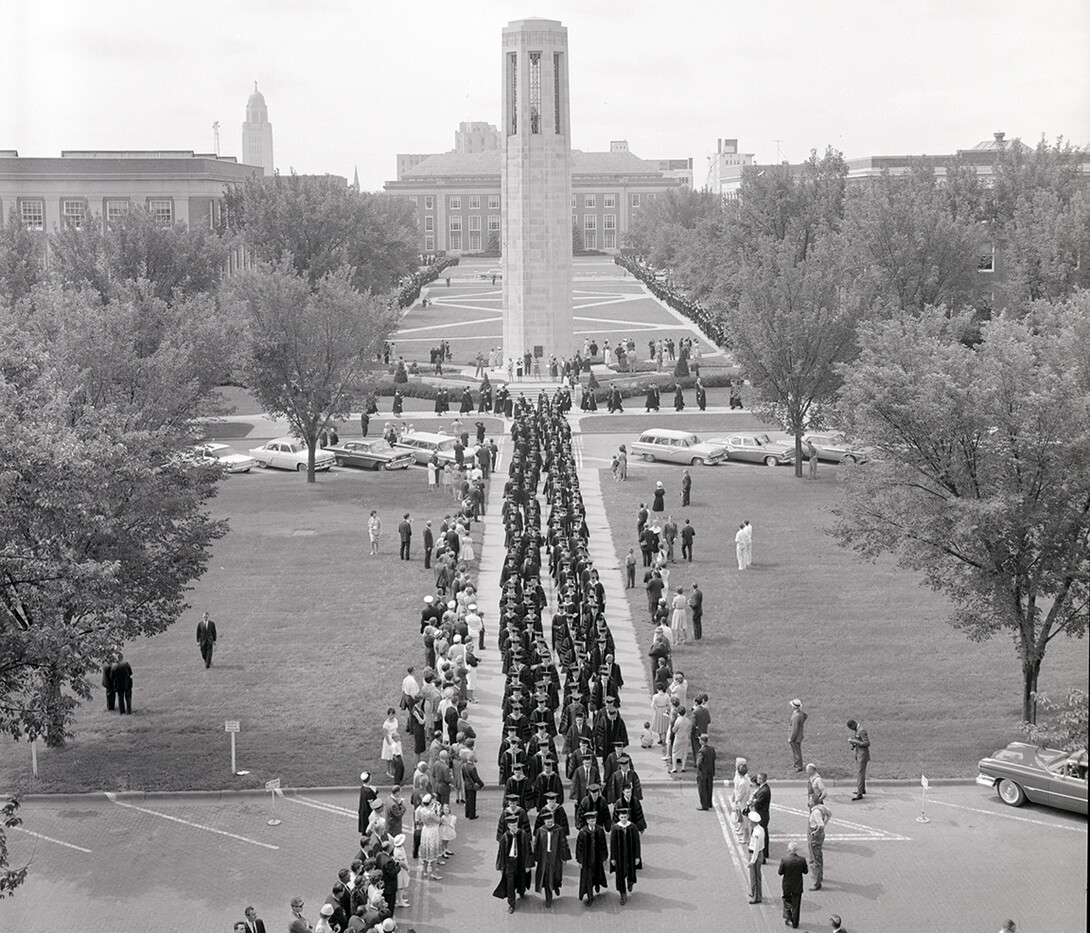
1920 to 1939
In February 1920, commencement was not held. A note in the university archives stated that the midyear commencement was discontinued because of a faculty senate action on Dec. 5, 1919, and graduate names would appear in the June commencement program.
Although Charter Day was still a celebrated event consisting largely of alumni functions, it no longer included conferral of degrees. Commencement would not be part of Charter Day again until the 1940s.
St. Paul’s M.E. Church was the location for commencements during the early part of the decade until the Coliseum opened on campus in 1926. The Coliseum would serve as a graduation site for 37 years, until Pershing Auditorium opened in 1963.
In the 1930s, alumni were very active during the commencement week, holding “Round-ups” for returning alumni. Local merchants would place newspaper ads welcoming round-up visitors in hopes of creating traffic in their stores. Hotels were busy with banquets for class and Greek society reunions.
Commencements during the 1930s were traditional, dignified and held much of the honor deemed appropriate to the occasion. And, speakers included prestigious chancellors, presidents and dignitaries of institutions from across the country.
Late in the decade, however, the mood changed as addresses were filled with political and cautionary comments about the world and the approaching war.
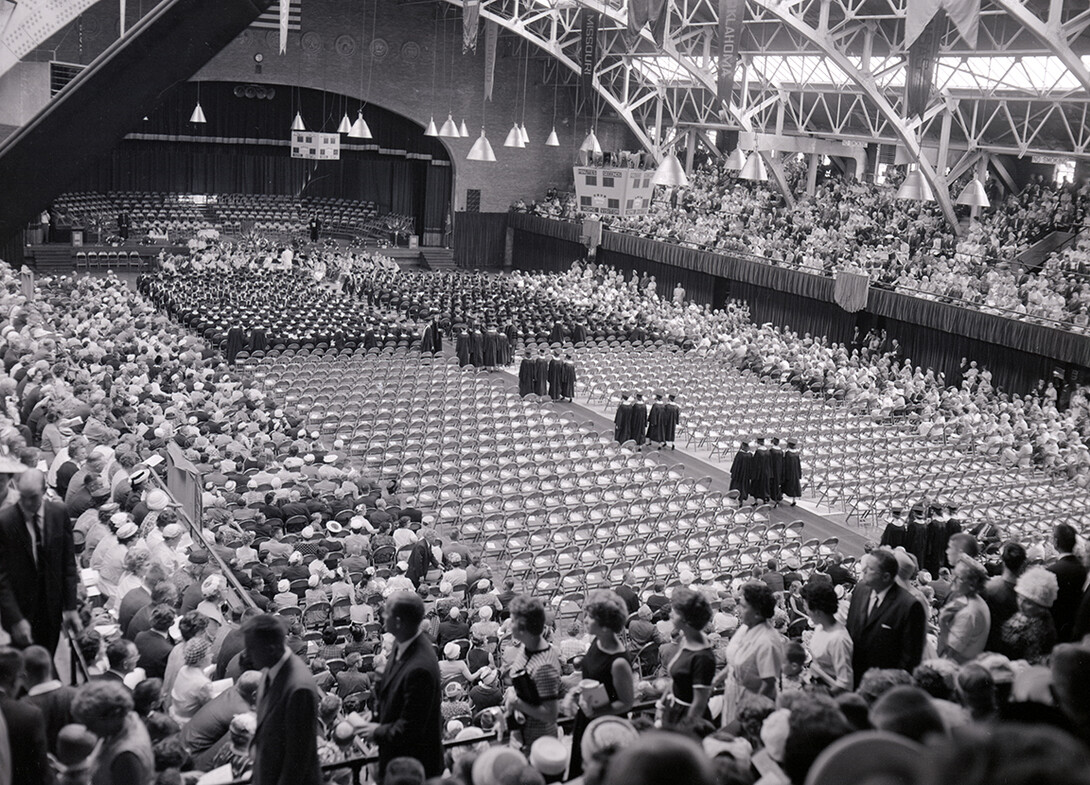
1940 to 1959
In the 1940s World War II had a tremendous impact on the campus and the commencement ceremony. And, returning soldiers produced one of the largest classes to date in 1949.
The 1943 graduating class was dubbed the “War Class” by Chancellor C. S. Boucher.
In his May 24, 1943 greetings booklet to the graduating class, Boucher said, “Because 1943 has witnessed the coming of the Army Specialized Training Program to our campus, your class will be known as the war class. We pray that the next class may be known as the year of peace.”
More than 325 senior male students attended 1943 commencement in uniform. The next morning they left for Fort Leavenworth, Kansas.
The builder Award and the Alumni Association’s Distinguished Service Award were created in the 1940s and continue to be conferred today.
Commencements of the 1950s were highlighted by appearances of well-known alumni such as author Mari Sandoz and U.S. Attorney General Herbert Brownell, Jr. The commencement ceremonies were held at various venues on campus and in the city. Outdoor ceremonies in the summer became an anticipated event in front of Memorial Stadium.
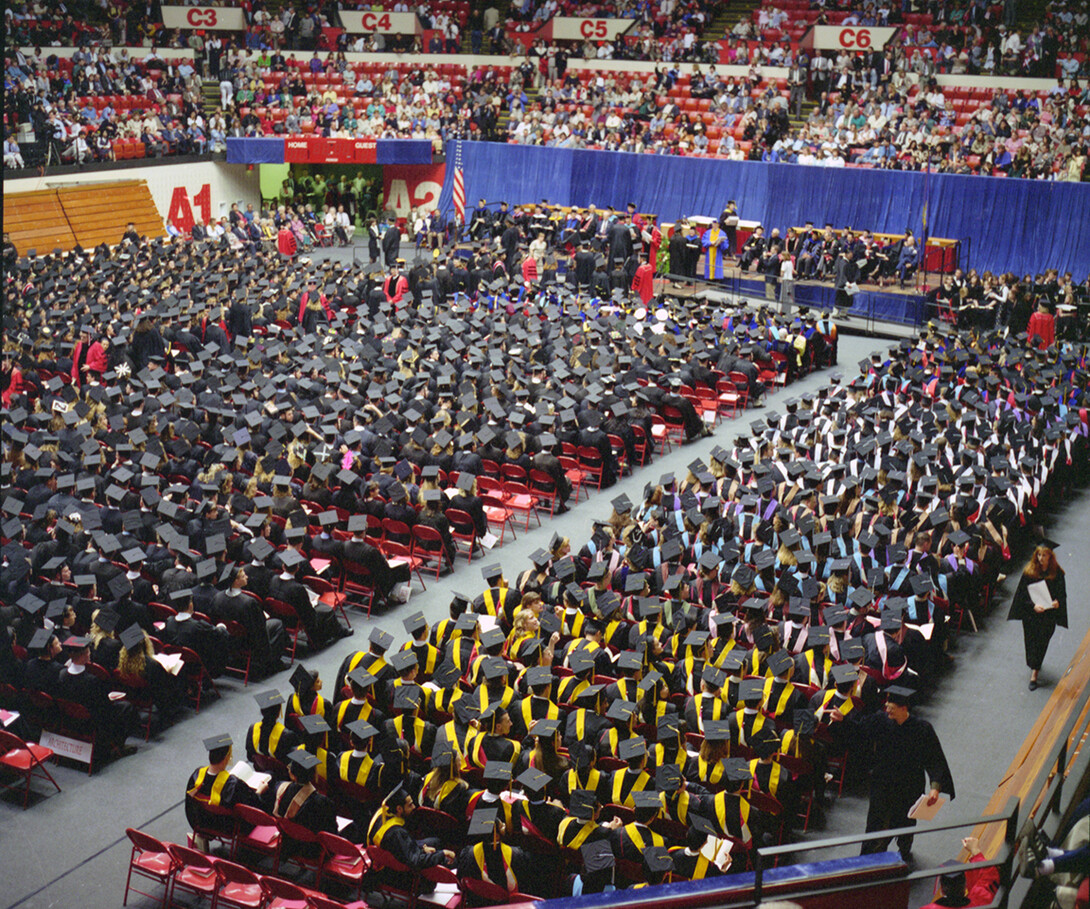
1960 to 1979
Commencements in the 1960s saw an increase in the number of degrees conferred due to the post-war baby boom.
Efforts to personalize commencements for large numbers of graduates continued to be a challenge to planners. The commencement location was changed to Pershing Auditorium amidst controversy and disappointment of graduates at the discontinuance of the grand outdoor procession.
During the spring semester of 1970, University of Nebraska–Lincoln students protested the shootings of demonstrators at Kent State University and the United States’ incursion into Cambodia.
The Kent State demonstration was still in the minds of administrators and students as they approached the 1970 commencement. Precautions were taken by university marshals and plans were prepared on how to handle riots or outbursts at commencement. The precautions were not needed and the ceremony went smoothly.
On June 6, 1970, 2,010 graduates received degrees, making it the largest graduating class in the history of the university. Because of the number of graduates, the ceremonies were divided into morning and afternoon sessions at Pershing Auditorium.
The Bob Devaney Sports Center was first used for commencement on May 8, 1976. This new location could accommodate more than 2,000 graduates and up to 15,000 attendees. This commencement exercise became a historical milestone, drawing national attention when the U.S. President Gerald Ford accepted the invitation to attend the ceremony and receive an honorary degree.
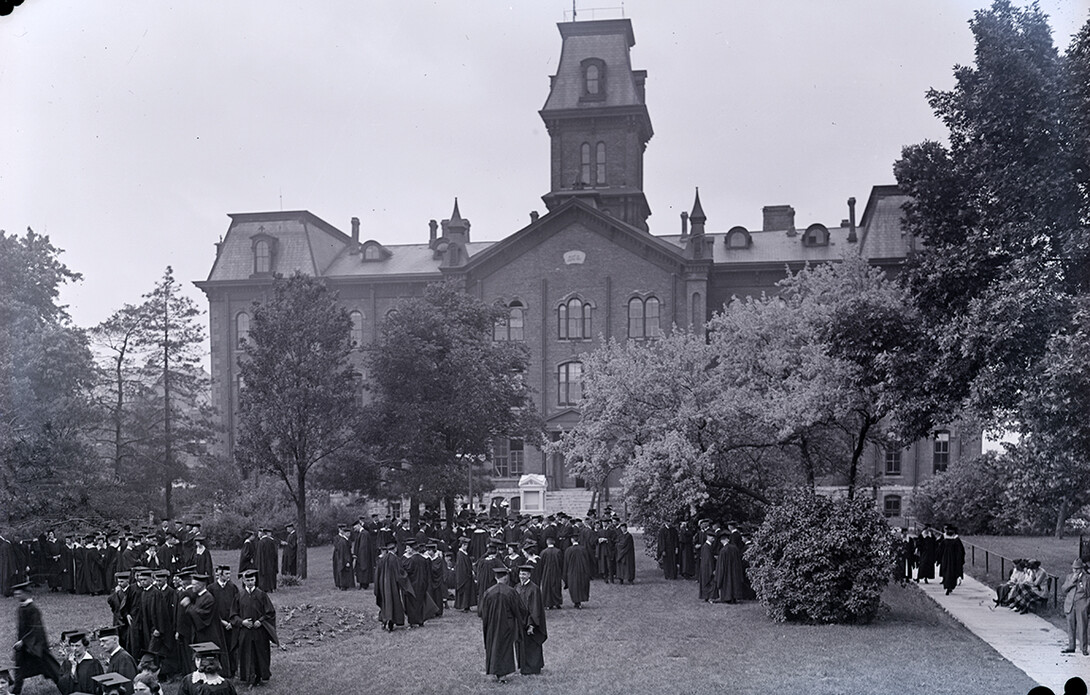
1980 to today
In the 1980s, 68 honorary degrees were conferred.
Although he was a graduate of Yale University, Dick Cavett said it was not until he received his Honorary Doctor of Letters degree from Nebraska in 1982 that he felt “truly educated.” The television star was the only one of the four honorary degree recipients that year to take the microphone and address the crowd of more than 2,000 degree recipients.
During the commencement address, Cavett explained to the audience that he was not notified of the honorary degree until three days before. Chancellor Martin Massengale had told Cavett he had mailed him a letter about the award several weeks prior to commencement.
Cavett remarked he could believe that, knowing the problems at the postal service.
“But, I’d believe it more if I couldn’t see where they’d scratched out Johnny Carson’s name,” Cavett said, holding up his degree.
In the fall of 1992, a debate began on the campus about prayer at commencement. The commencement committee had planned to ban the invocation and benediction from the traditional opening and closing commencement in response to the 1991 Supreme Court ruling banning district-sponsored school prayers at public schools. Protests were made by students from a broad spectrum of faiths, which led university officials to take a second look at the proposed ban.
Chancellor Graham Spanier elected to appease tension by having Keith Benes, the new student president, lead the student body in a moment of silence at the December 1992 commencement.
The debate continued into 1993, when in March a vote was put before the student body. By a 2-1 margin, the prayer was retained. In 1999, the prayer was changed to a greeting by the president of the Association of Students of the University of Nebraska.
For the December 1999, HuskerVision was first integrated into commencement exercises. The big screen video presentation, normally used for sporting events in the Devaney Center, was adapted to enhance the graduation event. Three cameras were set in the auditorium to capture on the big screen students receiving their degrees and to bring the faces of proud students closer to the audience.
Some of the most prestigious honorary degrees awarded by the University of Nebraska were given outside of commencement in 2000 and 2001. Degrees were conferred in special ceremonies held at the E.N. Thompson Forums on World Issues in the Lied Center for Performing Arts. The first was awarded to Archibishop Desmond Tutu and the second to former president of the Soviet Union, Mikhail Gorbachev.
Commencement exercises — which were streamed online after the turn of the century — continued to be held at the Devaney Center until 2012. In 2013, the celebration moved to Pinnacle Bank Arena, where it remains today.
As part of the university’s 150th year celebration in 2019, commencement exercises are getting an update.
Due to space limitations in Pinnacle Bank Arena, the one undergraduate ceremony on May 4 is being divided into two events. And, the celebration will include redesigned robes that will feature the Nebraska “N.” Read more about these changes and commencement schedule in Nebraska Today.
